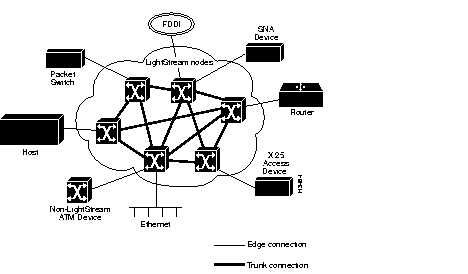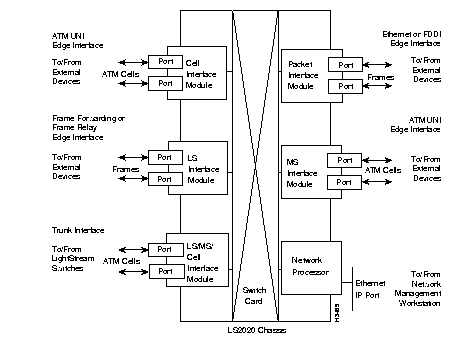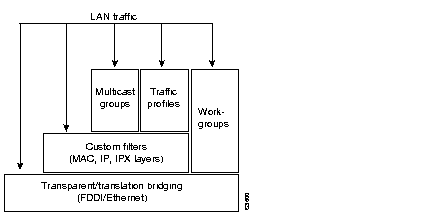|
|

This chapter begins with a brief description of a network of LightStream 2020 multiservice ATM switches (LS2020 switches). It then discusses configurable objects in the order that you encounter them as you configure an LS2020 node. For instance, it describes chassis and line cards first because you must configure them before you can configure ports on the line card. It then describes configuration items (such as PVCs and bridging) that can be defined only after ports have been configured.
LS2020 switches are connected to one another by trunk connections. Edge connections link LS2020 nodes to devices outside the LS2020 network backbone (see Figure 2-1).

For edge connections, the LS2020 switch provides
For trunk connections, the LS2020 switch provides
This section describes only the physical components of an LS2020 switch that have configurable attributes. For a description of all switch components see the LightStream 2020 Hardware Reference and Troubleshooting Guide.
The chassis is the basic configurable unit. Attributes associated with the chassis include chassis ID number, name, physical location, and line cards.
Each LS2020 chassis contains
Backup NP and switch cards may also be present. Figure 2-2 shows a logical block diagram of these components. Each component is described in one of the following sections.

The NP is the principal computational and storage device in an LS2020 node. Each node has one or two NPs. In a system with two NPs, one is primary (active) and the other is secondary (backup). The secondary NP automatically becomes active if the primary NP fails. One NP occupies slot 1, and the other, if present, occupies slot 2. Each NP is connected to a floppy disk drive (for loading software such as LS2020 application programs) and to a hard disk (for storage of the applications, configuration, and other data).
Configuration attributes associated with an NP include IP addresses and SNMP agent attributes.
An interface module includes a line card and an access card, which work together to transfer data. A line card provides higher layer data transfer functions. An access card provides the active logic for the physical layer interface for each port (line drivers/receivers, etc.). Each line card, therefore, is associated with an access card that determines the physical layer interface supported for its ports, such as OC-3c, T3, or EIA/TIA-449. In most cases, various access cards are available for each line card.
Table 2-1 shows currently available line cards and their associated access cards.
| Line Card | Access Card | Number of Ports |
|---|---|---|
| Low-speed line card (LSC) | Low-speed access card (LSAC) | 8 |
| Medium-speed line card (MSC) | T3 medium speed access card (T3 MSAC) E3 medium speed access card (E3 PLCP MSAC) E3 medium speed access card (E3 G.804 MSAC) | 2 2 2 |
| Cell line card (CLC) | OC-3c single-mode access card (OC3AC SM) OC-3c multimode mode access card (OC3AC MM) T3 access card (T3AC) E3 access card (E3AC) | 1 or 2 1 or 2 4 or 8 4 |
| Packet line card (PLC) | FDDI access card (FAC) Ethernet access card (EAC) Fiber Ethernet access card (FEAC) T1 Circuit emulation access card (CEMAC) E1 Circuit emulation access card (CEMAC) Serial access card (SAC) | 2 8 8 8 8 8 |
Most interface modules can operate as either edge or trunk modules. (The exceptions are the FDDI, Ethernet, fiber Ethernet, and CEMAC modules, which can operate only as edge modules.) Edge modules help transfer data between the LS2020 switch and external devices. Trunk modules help transfer data between LS2020 switches.
Settings in the switch's local configuration database, which are read at power-up, determine whether an interface module operates as a trunk or an edge. The configuration dictates the firmware and software to be used; the hardware is identical, whether the module is used as a trunk or as an edge.
Table 2-2 shows the services and physical layer interfaces that the edge modules support. Table 2-3 shows the services and physical layer interfaces that the trunk modules support.
Configurable attributes at the card level are name and type. After you specify these attributes, the configurator allows you to configure port-level attributes for the individual ports.
Edge Module | Service | Physical Layer Interface |
|---|---|---|
| LSC with LSAC | Frame relay or frame forwarding | EIA/TIA-449, V.35, X.21, T1, E11 |
| MSC with MSAC CLC with T3AC--4 or 8 port MSC with MSAC CLC with E3AC--4 port CLC with OC3AC SM--1 or 2 port CLC with OC3AC MM--1 or 2 port | ATM UNI | T3 E3 OC-3c |
| PLC with FAC | FDDI | MIC Multimode Dual attach station |
| PLC with EAC | Ethernet | AUI, 10BaseT |
| PLC with FEAC | Fiber Ethernet | 10BaseFL (FOIRL) |
| PLC with CEMAC | Clear channel | T1 E1 |
| PLC with SAC | Frame relay or frame forwarding | EIA/TIA-449, V.35, X.21, T1, E11 |
Trunk Module | Service | Physical Layer Interface |
|---|---|---|
| LSC with LSAC | Low-speed trunk | T1, E11 |
| MSC with MSAC CLC with T3AC--4 port MSC with MSAC CLC with E3AC--4 port CLC with OC3AC SM--1 port CLC with OC3AC MM--1 port | Medium-speed trunk | T3 E3 OC-3c |
| PLC with SAC | Serial trunk | T1, E11 |
Virtual channel connections (VCCs) connect source and destination hosts across an LS2020 network. Each VCC is associated with a software-selected route through the network. Route definition is based on the service requirements of the VCC. All traffic associated with that VCC follows the same route.
A frame relay or ATM UNI source host can be connected to multiple destination hosts and can have multiple connections with the same destination host. Similarly, an FDDI or Ethernet source can have multiple connections to one or more LAN hosts. However, a frame forwarding host can have only one connection to another device. The frame forwarding service provides a virtual wire between the two end systems. Each of the connections mentioned here has a separate VCC in each direction: from Node A to Node B and from Node B to Node A.
The LS2020 node establishes VCCs in either of two ways--by provisioning or by implicit setup. These methods are described in the following subsections.
You must provision for VCCs for the following line cards when the cards are configured as edge connections:
Provisioning requires that you define the endpoints of VCCs by configuring them manually through the PVC configurator. All VCCs set up in this way are permanent virtual circuits (PVCs). They are considered permanent for four reasons:
You can provision for a PVC before the network is brought online or while the network is operating. When you provision for a PVC, you specify the ports where it begins and ends. You also set a number of VCC attributes:
The PVC configurator allows you to configure PVC attributes for both ends of the PVC at the same time.
The PLC uses implicit VCC setup for LAN traffic. Implicit setup occurs when the PLC determines that a VCC with the desired characteristics does not exist between two endpoints. When this happens, the PLC works with the NP to establish a VCC to the destination and then routes the data across it. Although you do not provision for this type of VCC, you still need to configure the PLC and its port-level attributes. For other kinds of traffic, you must provision for PVCs.
VCCs that are set up implicitly on the PLC are not considered permanent for two reasons:
For traffic on PLC serial interfaces, you must provision VCCs using the PVC configurator.
The LS2020 switch operates as a fully compliant IEEE 802.1d-1990 bridge. The switch supports translation and transparent bridging for Ethernet-to-FDDI, Ethernet-to-Ethernet, and FDDI-to-FDDI connections. The PLC and associated access cards provide interfaces to FDDI and Ethernet LANs.
Using the node configurator (CFG), you can configure spanning tree bridge and static bridge filtering attributes for each LS2020 node.
If you purchased the VirtualStream software option for an LS2020 network handling LAN traffic, you can use the virtual LAN internetworking (VLI) services to separate network management, administration, performance, and scalability from the physical aspects of the network. Through VirtualStream, the LS2020 switch allows you to partition network devices according to the problem you are trying to solve.
There are four configurable VirtualStream services for handling LAN traffic:
The VirtualStream services work with one another and with the bridging software to control LAN traffic, as shown in Figure 2-3. LAN traffic can be affected by one or more VirtualStream services, or it may use the bridging service only.

|
|